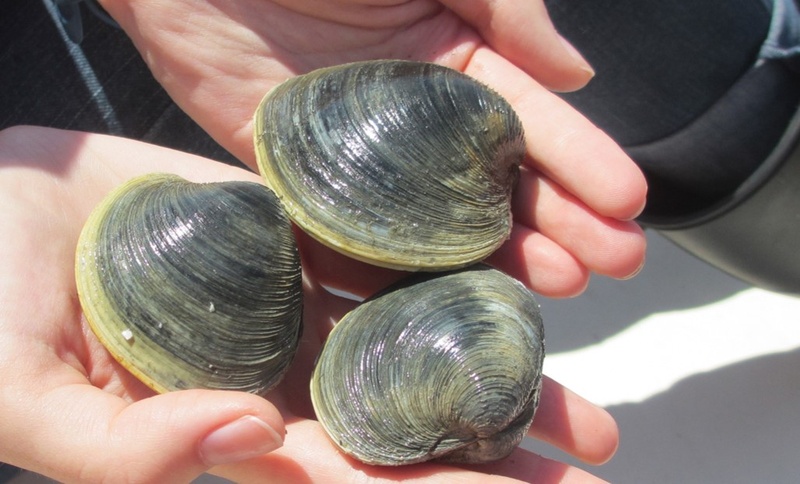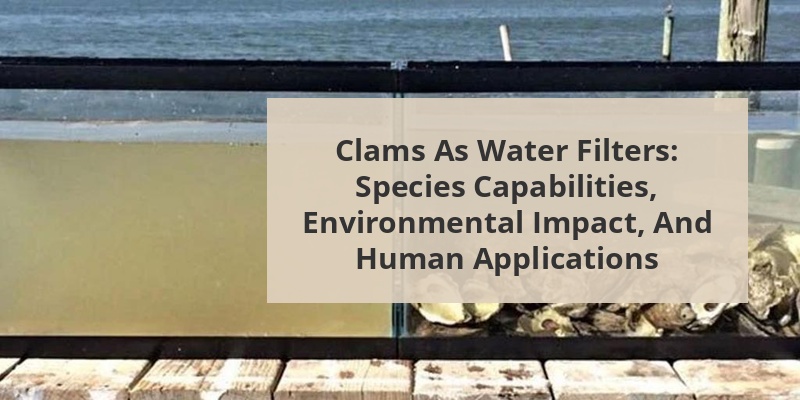Clams are remarkable bivalve mollusks that play a crucial role in aquatic ecosystems through their natural filtering abilities. These sedentary creatures actively filter water as their primary feeding mechanism, drawing water in through their incurrent siphon, extracting food particles, and expelling cleaner water through their excurrent siphon. A single adult clam can filter between 15-50 gallons of water daily, depending on the species and environmental conditions. This filtering process not only provides nutrition for the clam but also offers significant ecological benefits by removing excess nutrients, bacteria, and suspended particles from the water column, effectively serving as living water purifiers.
Clams filter water through a specialized biological mechanism that has evolved over millions of years. When a clam feeds, it opens its shell slightly and extends its siphons – tube-like structures that serve as intake and output channels. Water enters through the incurrent siphon, passes over the clam’s gills, and exits through the excurrent siphon.
The gills serve a dual purpose in clams: respiration and feeding. As water flows over the gill surfaces, tiny hair-like cilia create currents that trap food particles such as plankton, bacteria, and organic matter. These particles become caught in mucus and are directed toward the clam’s mouth for digestion. Meanwhile, unwanted materials are bundled into pseudofeces and expelled.
This filtration process is remarkably efficient. The clam’s gills contain thousands of microscopic filaments that create an extensive surface area for particle capture. These filaments can trap particles as small as 2-3 micrometers, which includes most bacteria and phytoplankton suspended in the water.
Content Navigation
Filtration Anatomy of Clams
- Siphons: Specialized tubes for water intake and outflow
- Gills: Primary filtration organs with extensive surface area
- Cilia: Microscopic hair-like structures that create water currents and trap particles
- Labial palps: Sort captured particles before they enter the digestive system
- Mantle: Tissue layer that secretes the shell and helps direct water flow
Filtration Capacity of Different Clam Species

The filtration capacity varies significantly among clam species, with some demonstrating remarkable efficiency. Freshwater mussels are among the most efficient filter feeders, with a single adult capable of filtering up to 15 gallons of water daily. Marine species like the hard clam (Mercenaria mercenaria) and soft-shell clam (Mya arenaria) also exhibit impressive filtration rates.
Size, age, and metabolic rate all influence a clam’s filtering capability. Larger individuals generally filter more water than smaller ones, while younger clams often have higher filtration rates relative to their body size. Environmental factors including water temperature, food availability, and water quality also affect filtration performance.
| Clam Species | Average Filtration Rate (Gallons/Day) | Habitat | Particle Size Removed |
|---|---|---|---|
| Hard Clam (Mercenaria mercenaria) | 24-50 | Marine | 2-100 μm |
| Soft-shell Clam (Mya arenaria) | 15-30 | Marine | 2-80 μm |
| Freshwater Mussel (Unio species) | 10-15 | Freshwater | 0.5-100 μm |
| Giant Clam (Tridacna gigas) | 40-100 | Marine | 1-50 μm |
| Asian Clam (Corbicula fluminea) | 5-25 | Freshwater | 1-70 μm |
Environmental Benefits of Clam Filtration

Clams serve as natural biofilters in aquatic ecosystems, providing numerous environmental benefits. By filtering suspended particles and excess nutrients from the water, they help combat eutrophication – the excessive growth of algae due to nutrient pollution. This filtering activity improves water clarity, allowing sunlight to penetrate deeper into the water column and supporting the growth of aquatic plants.
The filtering capacity of clam populations can be substantial. Historical accounts suggest that before overharvesting, the oyster population in Chesapeake Bay could filter the entire bay’s water volume in just a few days. Today, restoration efforts aim to revitalize these natural filtration systems.
Clams also contribute to benthic-pelagic coupling, transferring nutrients from the water column to the sediment. As they filter particles from the water and excrete waste into the sediment, they effectively move organic matter and nutrients between these two ecosystem compartments, supporting diverse benthic communities.
Key Pollutants Removed by Clams
- Nitrogen and phosphorus compounds that contribute to algal blooms
- Suspended sediments that reduce water clarity
- Bacteria and pathogens from the water column
- Microplastics (though this may harm the clams themselves)
- Heavy metals and certain chemical pollutants
Factors Affecting Clam Filtration Efficiency
Several environmental factors influence the efficiency of clam filtration. Water temperature significantly impacts metabolic rates in these ectothermic animals. Most clam species exhibit optimal filtration between 15-25°C (59-77°F), with reduced activity at lower temperatures and potential stress at higher temperatures.
Call 888-896-7031 for Free Local HVAC Quotes – Compare and Save Today!
Water quality directly affects filtration performance. High levels of silt, clay, or other inorganic particles can clog the clam’s filtering apparatus, forcing it to expend energy clearing these materials rather than feeding. Similarly, elevated pollution levels—including heavy metals, pesticides, and other contaminants—can stress clams and reduce their filtering activity.
Population density plays a crucial role in the collective filtering impact of clams. Dense aggregations can process significant water volumes, but overcrowding may lead to food limitation and reduced individual filtration rates. Seasonal variations also affect filtering behavior, with many species showing peak activity during spring and summer when phytoplankton is abundant.
| Factor | Impact on Filtration | Optimal Conditions |
|---|---|---|
| Water Temperature | Directly affects metabolic rate | 15-25°C (59-77°F) |
| Salinity (for marine species) | Influences osmotic balance and energy expenditure | Species-specific, typically 25-35 ppt |
| Dissolved Oxygen | Determines respiratory efficiency | ≥ 5 mg/L |
| Turbidity | Can clog filtering apparatus | Low turbidity, < 30 NTU |
| Pollutant Levels | May cause stress and reduced activity | Minimal pollutants |
Human Applications of Clam Filtration

The natural filtering ability of clams has inspired various human applications in environmental management and water quality improvement. Bivalve aquaculture serves a dual purpose of food production and environmental remediation, particularly in nutrient-enriched coastal waters. Integrated multi-trophic aquaculture systems strategically place clam beds downstream from fish farms to filter excess nutrients and organic waste.
Environmental restoration projects increasingly incorporate clams as a natural solution to water quality issues. Programs to reintroduce native clam species to degraded waterways help restore ecosystem functions and improve water clarity. For instance, the Billion Oyster Project in New York Harbor aims to restore oyster reefs that once filtered the entire harbor’s water every few days.
Clam-inspired filtration technology has led to biomimetic innovations in water treatment. Engineers studying the efficiency of clam gills have developed membrane filters that mimic their structure and function. These bio-inspired designs often achieve greater efficiency with lower energy requirements than conventional filtration systems.
Examples of Clam-Based Water Improvement Projects
- Chesapeake Bay Oyster Restoration: Large-scale effort to restore filtering bivalves to improve water quality
- Green Mussel Cultivation in eutrophic bays of Thailand and Philippines
- Ribbed Mussel Bioremediation in urban waterways like the Bronx River
- Hard Clam Aquaculture in Florida’s Indian River Lagoon to combat algal blooms
- Watershed Restoration using freshwater mussels in rivers throughout North America
Scientists are also investigating the potential use of clams as biomonitors for environmental pollutants. Since these animals accumulate contaminants in their tissues as they filter, they provide valuable information about water quality over time. Researchers can measure pollutant levels in clam tissues to assess environmental conditions and track changes in ecosystem health.
Call 888-896-7031 for Free Local HVAC Quotes – Compare and Save Today!
Tips for Getting the Best HVAC Prices
- Prioritize Quality Over Cost
The most critical factor in any HVAC project is the quality of the installation. Don’t compromise on contractor expertise just to save money. - Check for Rebates
Always research current rebates and incentives — they can significantly reduce your overall cost. - Compare Multiple Quotes
Request at least three estimates before making your choice. You can click here to get three free quotes from local professionals. These quotes include available rebates and tax credits and automatically exclude unqualified contractors. - Negotiate Smartly
Once you've chosen a contractor, use the proven strategies from our guide — How Homeowners Can Negotiate with HVAC Dealers — to get the best possible final price.

